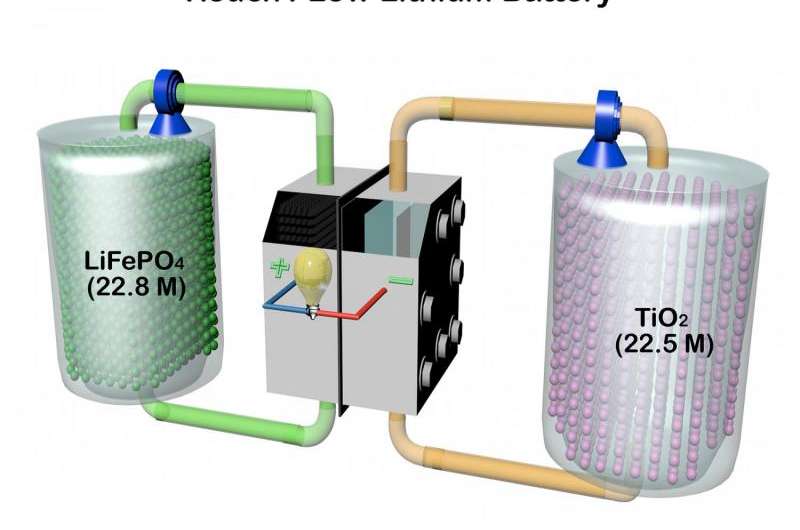November 30, 2015 report
New redox flow lithium battery has ten times the energy density of current RFBs

(Tech Xplore)—A team of researchers working at the National University of Singapore has developed a new hybrid redox flow battery (RFB) that they claim has ten times the energy density as conventional RFBs. In their paper published in the journal Science Advances, the researchers describe how they combined lithium battery ideas with RFBs and altered the membrane generally used in RFBs to come up with a battery they call the redox flow lithium battery (RFLB).
In order for renewable energy sources such as wind and solar to work on a large scale, a new type of battery technology must be developed—the current leading contender is the RFB, but it does not have nearly the energy density capacity needed for large scale operations. Lithium batteries, on the other hand, have a much higher density but are not scalable to the size needed for industrial applications. In this new effort, the researchers sought to combine the two technologies to come up with a battery that might one day be the breakthrough scientists have been looking for.
RFBs work by storing charges in liquid electrolytes in large tanks—the electrolytes are pumped through a stack which has two electrodes in it that are separated by an ion-conducting membrane. Such batteries can be scaled up by using bigger or more tanks, but doing so becomes more and more ungainly and expensive—a better approach would be to improve the energy density, which is approximately one tenth that of lithium batteries.
In the new approach the team in Singapore replaced the liquid electrolytes in the tanks with solid lithium materials—one holds lithium iron phosphate, the other titanium dioxide. They then added a charge-carrying liquid to carry the charges from the porous solids in the tanks to the stack and back. Then, they added a new kind of membrane in the stack, one that used a conventional material called Nafion combined with another polymer—the new membrane was better at allowing lithium ions to pass through. The end result, the team announced after testing, was an RFB hybrid with ten times the energy density of conventional models.
There is still one major hurdle to overcome, as the team acknowledges, the RFLB is far too slow to be useful in a commercial application, 10,000 times slower than conventional RFBs—the group believes they will be able to speed it up though, by modifying the membrane and charge carrying mediators.
More information: C. Jia et al. High-energy density nonaqueous all redox flow lithium battery enabled with a polymeric membrane, Science Advances (2015). DOI: 10.1126/sciadv.1500886
Abstract
Redox flow batteries (RFBs) are considered one of the most promising large-scale energy storage technologies. However, conventional RFBs suffer from low energy density due to the low solubility of the active materials in electrolyte. On the basis of the redox targeting reactions of battery materials, the redox flow lithium battery (RFLB) demonstrated in this report presents a disruptive approach to drastically enhancing the energy density of flow batteries. With LiFePO4 and TiO2 as the cathodic and anodic Li storage materials, respectively, the tank energy density of RFLB could reach ~500 watt-hours per liter (50% porosity), which is 10 times higher than that of a vanadium redox flow battery. The cell exhibits good electrochemical performance under a prolonged cycling test. Our prototype RFLB full cell paves the way toward the development of a new generation of flow batteries for large-scale energy storage.
© 2015 Tech Xplore
















